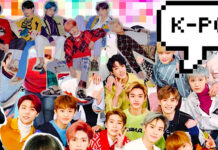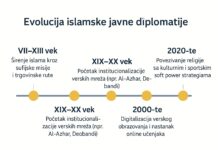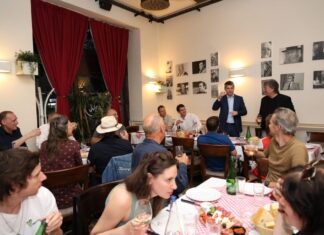We have asked several foreign ministries to answer some questions about their #DigitalDiplomacy. Here’s a guest post from the Government of Montenegro.
Which is/are your preferred social media channel(s) and why?

We launched our social media presence, a first for a country in the Western Balkans as far as we know, in 2011. Our preferred social media channel which I will focus on here (and the first one we started using) is Twitter, and for several reasons. First, it allows for quickly sending messages out to a large number of people. Second, it makes you focus on what is the most important, stripping away all the bureaucratic language usually found in press releases and similar ‘traditional’ ways of government communications. Third, it lets you exchange with other countries, individuals, governments, and officials, opening room for making better services, improving relations, and doing some public diplomacy. Most importantly, it allows you to listen to the people and understand their needs. And finally it is a very cheap way of communicating that offers disproportionately large benefits when compared to the investment. Initially, we launched a Twitter channel in English (@MeGovernment), as our chief aim was to communicate more information on Montenegro to international audiences, which we found was lacking. Later on, as the Twitter community in Montenegro grew, we repeatedly pushed from within and got pressure from the public to start communicating more with our domestic audiences. An OK was given in 2012 and we launched another account (@VladaCG) targeted at the domestic audience. We have around 30 thousand followers on the two channels combined and very good engagement, which gave us admirable ranking on several Twiplomacy surveys in the past (thanks, guys!).
We plan to expand our social media presence very soon, and we already took some steps in that direction (read on!). Our social media team is centred at the Government’s PR Service, and the team in other departments is expanding slowly but steadily.
Please share an example of your best campaign/engagement on social media.
I dare say we have been particularly successful in live-tweeting from events, which is an activity where we have the most structured approach. On several occasions, including last month, we were lucky enough to have central news broadcasts in the country launch with the messages we sent via Twitter.
The way we do it is that we try to collect as much as possible the materials pertaining to the event in advance (such as speeches, talking points, key messages, visual stuff, documents, etc.) so we can prepare some key messages in advance. After we double-check these we go to the event and follow closely for any additional messages that should be communicated. We also try to take some good photos/video and come up with some catchy messages. Tagging people and using good hashtags can also help spread the word, in addition to well-tailored messages. To do all this well, it takes knowledge of the topic, understanding of the medium and the needs of the audience, taking good imagery, and applying some common sense. That is our recipe and it has proven good most of the time for us. We have learned on the go and we believe this is the best way to do it. There are no ready-made success guidelines for everyone, but practice makes perfect (we’re yet to get there, though).
When it comes to sharing some practical lessons we learned along the way, I believe the most essential thing is to tailor good-sounding, relevant, and interesting messages, or else no one will care about what you have to say. An added bonus is if you can have something exclusive, not heard elsewhere. That really draws attention. Then hashtags are very important — they act as links and allow for related messages to be followed as a thread, which is very important in live events and campaigns. We came up with some really important ones which were even trending and some are still alive and well years after we launched them. Not to be overlooked is the fact that there are people behind the channel and Twitter allows you to show the human side. This should be done even on institutional accounts when the need calls for it, such as at times of suffering or joy. Some of our most popular tweets have been related to sporting events and expressing solidarity in times of crises.
Oh, let’s not forget the most important thing about Twitter: you must be quick or you’re not relevant. On several occasions we tweeted without necessarily going through the full cycle of approval (for some sensitive matters we must require permission) but tweeted because we believed it needed to be done quickly. A few times we almost got in trouble, but most of the time we were vindicated by our success.
How do you measure success on social media?
As anyone who does social media for governments can tell you, this is the hardest and most elusive part of the job. You keep getting those questions and you keep remaining in want of a good answer. There’s a plethora of tools that we use, but their reliability is debatable. It will still take some time for the AI to reach that level where we will be able to have solid and fully relevant measurement tools. We try to look at the feedback from our audiences and peers the most, and also the traditional media coverage, as that is still considered the most relevant in our context. We take these as indicators and combine them with our own understanding of social media trends and developments, and we spice it up with some statistics such as the number of followers, shares, etc. to make it relevant for some of our more old-fashioned colleagues.
It is important to note that there is two of us doing social media at our department (the central government PR office). And it’s more like half of me and half of the other person, as we have plenty of other tasks to do. But we are digital natives and and always staring at our phones, so it’s also fun for us. Even when we have to tweet on weekends and evenings, much to the chagrin of our families and friends.
But we got, or better say fought for, the support of our superiors and we are currently working on expanding our social media presence. I would say this is our greatest success in measuring social media success — convincing people it is something a government must do today. And we did it by trail-blazing hoping our results will speak for us. And they did. We slowly and carefully started meddling in Facebook, first as a project for a specific Government policy and we will hopefully soon launch a central Government page. We convinced quite a few ministries to launch their own Twitter channels and we help them with these almost daily. Also, in the run up to the 10th anniversary of the restoration of Montenegro’s independence on May 21, 2016 we quietly launched Instagram and Vine. There’s some fun content there, so make sure to check it out! We have been using YouTube for longer speeches and press conferences, and we will also be using Vimeo. Most of these are still in test phases, though.
We identified there is a growing interest in Government departments for social media, but also some fear and need to improve knowledge and capacities. For this reason we’ve been sitting down with our peers from countries and international organisations who have gone through similar processes before us and we’ll be taking some best practices and organising trainings and exchanges for our colleagues from the departments. We are extremely grateful to them for offering help and assistance and we strongly encourage all governments who struggle with social media to seek help and start tweeting today. At our office we firmly believe that social media is the future of media and communications.
By Stefan Vukotić (@mraristocat), Head of International Communication at the Government of Montenegro (@MeGovernment @VladaCG)













